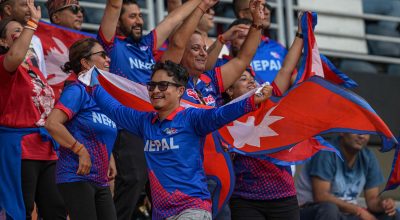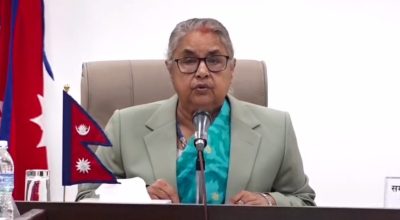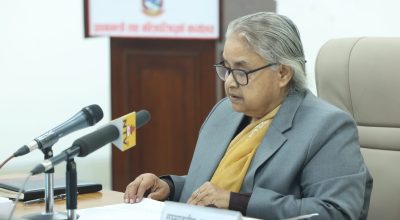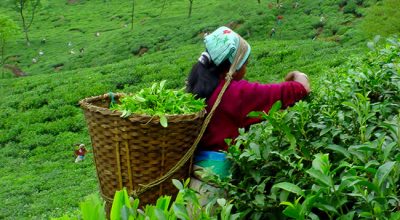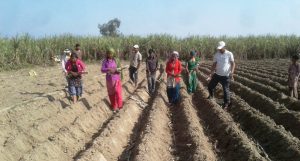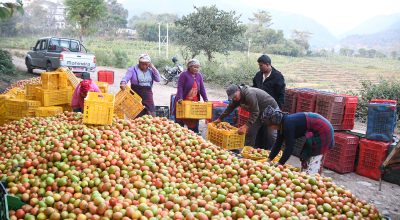
Narayan Prasad Ghimire

Festivals: Bridging Families
What does home mean to you? Among various answers and interpretations, some of you may respond to it as togetherness, family bond, sharing and caring, love and affection, parents, siblings, children, relatives, childhood, friends, birthplace, properties, and so on.
In addition to these, what would you think when one responds to it as ‘a week-long tryst in a year’? It would not be unfair to say- for many of us, living in the Kathmandu Valley for long, the home must have been distanced- a week-long stay in a year indeed.
Except for emergency events, it is only the festivals that bring family members together- a return to home, that too, an annual trip! It does not mean that you have no homes, no families, and no relatives here in Kathmandu, the federal capital, where you might have spent decades for study, employment and service. But why does the house you built here, the family you created here, the relatives and friends you have spent time here every day still fail to give you the sense of ‘home’ to you? Why does the home where you spent your childhood haunt you?
The home is where the heart is! Similarly, in a Hindu family, festival, having cultural and religious values, is the strong medium to bring together the family members.
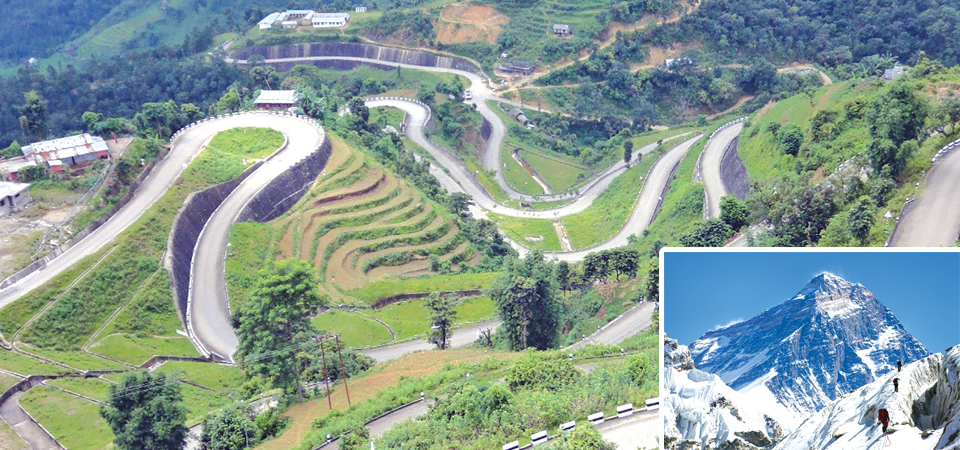
However, this past season, the biggest festival, Dashain, did not bring the same aura. Dashain too failed to entice the family members. ‘Distance, distance yourself from others’ was the ubiquitous message hovering around every human being. The family bridge created by the festival also diminished. Physical distancing, social distancing became the new normal, and the norms as well. It was all because of the notorious pandemic- the coronavirus- that swayed everyone with fear. Individual ‘self’ became the most valued thing. The crisis put everyone to revisit the meaning of life, making us more individualistic and self-centred to save individual lives.
The coronavirus pandemic had already taken a toll in the foreign countries. Many Nepalis too lost lives. The only effective measure was the lockdown or the stay at home order imposed by the government before the Dashain to contain the sinister.
Educational institutions were closed; industries and companies closed; market places closed; public spaces closed, and only open were the offices and stations to provide essential services. The social animal was under arrest- the house arrest! But, as the festival, as said earlier, is such a mighty bridge of utmost value, the lockdown was relaxed- to ease the movement of people for a family reunion. Scared a lot, I did not leave my house in Kathmandu during Dashain. Despair and dejected, the Dashain deluded the aura. Relatives immured; I too followed suit. But, how long to fear, and how long to fuss? The fear and fuss over the self! There is a next festival-Tihar. Thank God, we are rich in festivals too!
‘Buck up yourself!’ The inner being in me prodded. Then I chased away the timidity and fear, the fear of coronavirus, the fuss over life. With this, I left this crowd, the jungle of concrete, for my home to celebrate Tihar, the festival of colour, light, and flowers. The pristine streams, serene surrounding, lush green hills, peace with the absence of cacophony of honking wheelers, that is to say, the sense of rural life pulled me.
Highway on Hills: A Huge Relief
I remember those days of sheer inconvenience, difficulty and turmoil we, the people from Okhaldhunga, Khotang and Solukhumbu districts, faced before the construction of BP Highway (Banepa to Bardibas) linking the Kathmandu Valley to Tarai districts in the east. We, the hill people, however, use this Highway only up to Khurkot, Sindhuli and continue straight along the Sunkoshi River banks till Ghurmi, the northern tip of Udayapur district, which is connected to the southern tip of Okhaldhunga district.
Earlier, the travel via Tarai districts was not only costlier but also time-consuming- almost a day bus ride from Kathmandu to Katari, Udayapur. There were scary days during the Royal takeover: We had to get off the bus for nine times from Nagdhunga, Kathmandu to Katari, Udayapur to be frisked by the security persons as it was the state of emergency. Sometimes, we used to travel on bus hood in the Sajha Bus throughout the day to reach Kathmandu from Katari after leaving home with the celebration of Dashain and Tihar festivals. But, what a tragic fate the Sajha Bus met in Nepal! It needs a separate discourse, which I do not mention here.
Thank God, it was incremental development- BP Highway was constructed. It was/is a huge relief and convenience to the people from hilly districts. The time has hugely curtailed- the city-village travel limiting it to less than a day jeep/bus ride! When we had to visit via Mugling-Narayangadh to the east Terai and move up the north from Mirchaiya of East-West Highway via inner Madhesh (Katari bazaar of Udayapur), it almost took one day ride from Kathmandu to Katari and then still two days trek from Katari to Rampur, my village in Okhaldhunga.
Before the BP Highway came into full operation in 2015, there was bus service from Katari (south plains in inner Madhes) to Ghurmi (northern tip linking to hilly districts) of Udaypur. The life before the Ghurmi-Katari bus service (three-hour bus ride) was torturous as mentioned earlier. The three-hour bus service was equal to one-day trek- through the streams, across the jungle, and up and down the hills. A tiresome and rigorous trek!
One may wonder how the roadway from Katari to Okhaldhunga and Solukhumbu via Ghurmi was initiated. Yes, the concept of developing roadway linking Tarai district to hilly and mountainous districts was materialised after the restoration of democracy in 1990. In this connection, noted journalist Homnath Dahal, who hails from Rampur, Okhaldhunga, remembers that the development of roadway opened up avenues for change in Okhaldhunga, Solukhumbu and Khotang districts. He further shared, “An information committee was formed to study and suggest for road construction in the above districts immediately after GP Koirala became the Prime Minister with the restoration of democracy. The committee having members including myself, then lawmaker Balaraj Karki and others recommended GP Koirala to construct roadway linking Katari bazaar to Okhaldhunga district and then to Solukhumbu via Ghurmi. Koirala then called the line minister and asked to forward the process for it. Even then lawmaker Bal Bahadur Rai had an important role.”
According to Mr Dahal, the committee knew that in the final days of Panchayat system, even a plan was afoot to link Gaighat, district headquarters of Udayapur, to Diktel, district headquarters of Khotang, and then to Salleri, Solukbumbu, which he argued was too lengthy and zigzag. So, re-routing it in Katari-Ghurmi-Okhaldhunga bazaar-Solukhumbu was proposed which got immediately endorsed. Before BP Highway, the Ghurmi-Katari section had lessened the treks to reach the downhill and Tarai- Katari bazaar.
When it comes to reaching roadway in Okhaldhunga, some argue that the late Bal Bahadur Rai had an unforgettable role. The elderly ones in my village still remember that the late Rai, during the election campaign, had made a resolution that he would link the district to road access, and if not, he would finish himself. He had introduced himself as ‘gidangge sailo’. To him, some regard as a bold and assertive leader having the capacity to impress the Koirala family as well.
Siddicharan to Byakul Maila
Okhaldhunga district was initially made popular by poet Siddhicharan Shrestha with his lyrical poem, ‘Mero Pyaro Okhaldhunga’. With this included in the school curriculum, many knew about Okhaldhunga. In the later phase, dozens of journalists working in the federal capital, Kathmandu, are from this district. Lately, the district got further popularity with the national anthem ‘Sayau Thunga Phulka Hami Yeutai Mala Nepali…’. It is composed by Byakul Maila, resident of Okhaldhunga district. Similarly, the role of journalists and businesspersons hailing from the district is significant in national affairs.
Itinerant holiday
Yes, after reaching home, this time, I did not limit myself meeting friends and relatives but had travelled in the surrounding villages and hills. Call it development or mull whether it is development- every hill has the road! Is it only ‘dozer kheti’ or systematic planning and need-based approach? It too may need a separate study. However, I admit and appreciate that the travel was comparatively easier, better.
Although the most palpable changes found while visiting the surrounding villages and hills was that tracks were opened, it is not sure how many years the tracks change into roads- motorable pitch roads. I remember: three years back, I was told that the road from my district headquarters to my village (45 min jeep ride) would be blacktopped within six months, but as I go to my village this time, the road is same and my ‘when the question’ is answered ‘after six months’!
Anyway, the travel upward the hill to see the highest peak in the world, Sagarmatha, was really exciting. After a long time, I was visiting my district and neighbouring Solukhumbu district. A group of fun-loving boys packed the jeep heading to Pattale, a place from where the world’s highest peak can be seen. It is just two hours’ ride from Okhaldhunga bazaar. Located at the height of 2,850 meters, Pattale’s serenity and salubriousness entice everyone. Snow-clad mountains are seen near; Salleri bazaar, district headquarters of Solukhumbu, is seen clearly- still in the north. While moving up from Ramailodanda of Okhaldhunga, several scenic places and villages could be viewed from the height. The sun striking the hills and mountains and snow glittering mesmerize visitors. Suddenly, I remembered that once the government had proposed film city in Dolakha district, but why not in Okhaldhunga? Aren’t Jantardhap of Okhaldhunga, and Pattale of Solukhumbu scenic places for film shooting? These places are desperately waiting for tourists. My team took photos of mountains though not knowing which exactly was the Sagarmatha. With the cold getting biting, we returned after an hour.
Bare Sagarmatha
While returning home with a brief visit to the upper hilly area, whether we saw Sagarmatha became a huge debate in my expedition. Then why not to settle a case before a judge? All of us agreed and asked a local hotelier and tourism entrepreneur. “Come here, and see properly. But, you can’t see the Sagarmatha now because it is blanketed by the cloud. You know, there is no snow- the highest peak of the world is bare.” It was what a tourism entrepreneur Raju Magar told us to ascertain the Mt Everest. He made it clear that my team saw just the number peak. Again, my team member asks, “How long has it been the Everest without snow, Dai?” Magar responded, “Oh, it might be a decade I think.”
Although I had studied many news stories about the snow melting and the mountain including Sagarmatha getting denuded, I was further shocked when the mountain denizen shared it exuding despair, “Melting of snow on the peaks is a bad omen for people, livestock, plants, fruits, and crops.”
At the end of the brief conversation, I asked him, “Dai, what do you need here for the development of your family and village?” He immediately replied, “Tourists, foreign tourists.” According to him, his hotel business had plunged with no arrival of tourists in the wake of Covid-19 menace in the country.
Governance and Development
With the local levels in place after the adoption of federalism, learning the views of villagers could be another knowledge gain to me. In most of the conversation, I found them happy especially to get the social security allowance at their doorsteps.
Elderly people, single women and Dalit, differently-able people and those from the marginal community get the allowance from the nearby ward offices. Communication is easily established with the people’s representatives. The use of the smartphone has upped. You need not wonder if you see the people talking to their children and relatives in the cities and abroad, taking internet data pack. The revolution in communications is a marvellous achievement. With the data pack facility from internet companies, the youth and teenagers’ TikTok videos are commonplace on the Facebook page.
In this regard, I was dogged with the question- whether the change is meaningful and development activities conducted in a planned manner. So, I talked to a journalist, Kumbha Raj Rai, who has been reporting with a focus on Okhaldhunga district for over a decade. To my queries around governance and development activities, Mr Rai said, “Compared to the past, we can observe a change in service delivery at public offices. The efforts to go digital is positive. At the beginning of the establishment of local governments, the local levels were in unhealthy competition to reach road tracks to their villages and wards which wasted too much money. However, after some years, they came to know that roads should be made in a planned and engineered manner. In terms of employment and business, there is no noticeable commercial farming and entrepreneurship but few cases of goat-rearing and poultry farming in the district.” In my question whether all roads that seem to scratch the hills in many places were made with a proper plan, he replied ‘No.’
Need For Holistic Development
Finally, my visit to the surrounding hills during the festival holiday was not only a huge relief to monotonous city life but also the knowledge trip. I found the construction of tourism infrastructures like hotels and resorts, the announcement of tourist destinations, access to motorable/durable are urgent needs in Okhaldhunga and Solukhumbu districts. Similarly, a serious study on climate change effects and the launch of adaptation programmes were pressing issues. Although those days of arduous life of common people, traders and trekkers have ended in these districts, the roadway is yet to be liked to holistic development. Reaching loads of trucks and containers to villages and sending them back all empty is a serious problem. It is a huge development gap. So, it warrants attention from all sectors to establish commercial farming, augment tourism infrastructures, promote entrepreneurship, and restore small and cottage industries. Roads must not be limited to reach city goods to villages, but city facilities as well. (source: The Rising Nepal)







